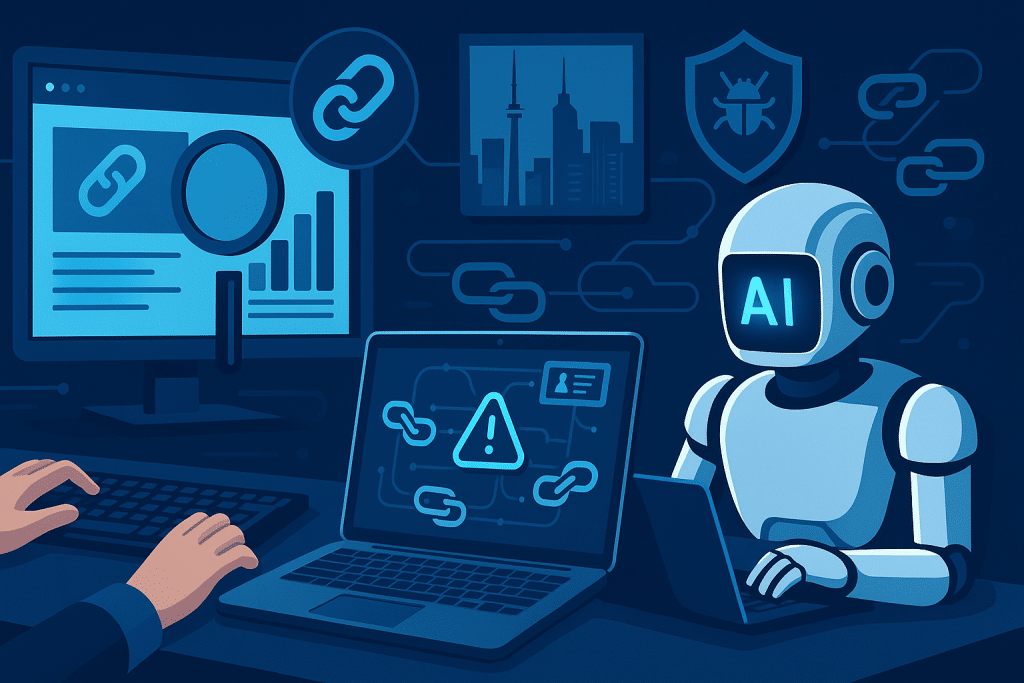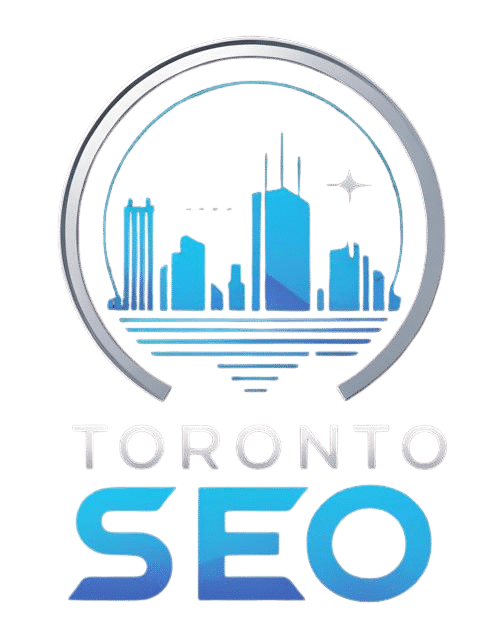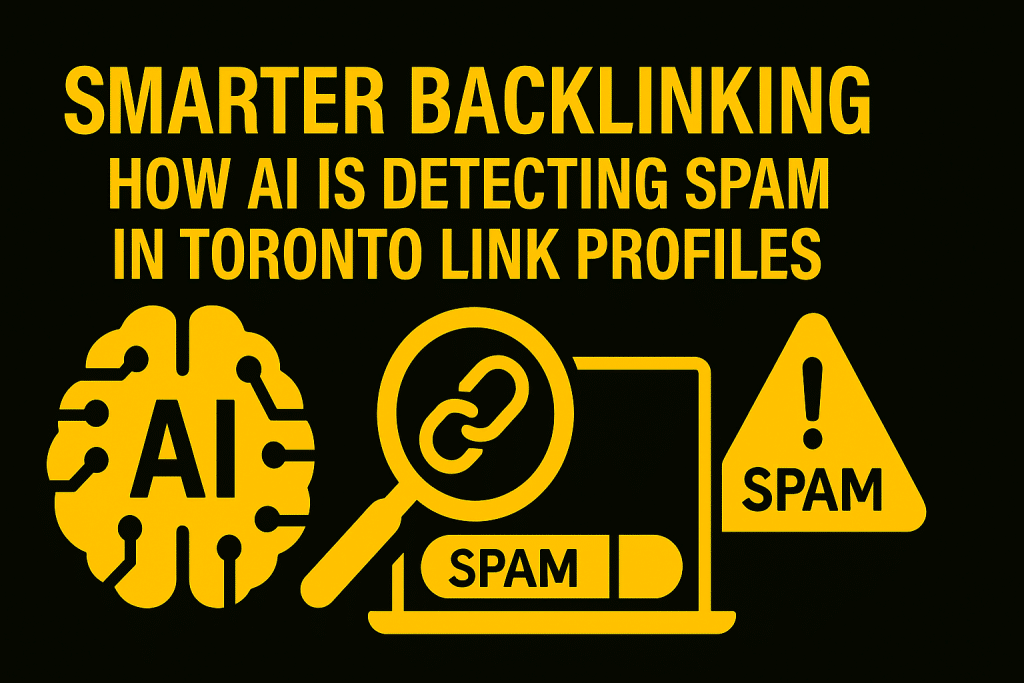Artificial Intelligence has quietly transformed one of the most critical aspects of SEO—link building. In Toronto’s hyper-competitive SEO landscape, traditional backlinking tactics are being scrutinized more closely than ever. Search engines now leverage AI-driven systems to detect spammy link patterns with unprecedented accuracy. As a result, Toronto businesses must rethink their link acquisition strategies to maintain rankings, avoid penalties, and build sustainable authority.
This in-depth guide explores how AI is reshaping link profile analysis, what tactics are triggering spam filters, and how smart marketers can adapt to these changes to build stronger, cleaner backlink profiles that stand the test of time.
The Rise of AI in Backlink Analysis
Search engines like Google have long used algorithms to detect manipulative link schemes. But recent advancements in machine learning and natural language processing have taken link analysis to a whole new level. Google’s SpamBrain, for example, uses AI to evaluate not only the quantity of backlinks but also the contextual relevance, anchor text diversity, placement patterns, and semantic relationships between linked content.
For Toronto SEO professionals, this means that legacy link-building tactics—such as buying links, participating in link farms, or using automated directories—are not just ineffective, they’re risky.
Understanding Google’s latest algorithm update is crucial because AI is now trained to detect nuances that human reviewers might miss, such as unnatural linguistic footprints and repetitive thematic clusters that indicate spam.
Why Toronto Link Profiles Are Under Increased Scrutiny
Toronto is home to a thriving ecosystem of marketing agencies, startups, law firms, real estate companies, and service businesses. This creates a highly competitive environment where link-building shortcuts have historically been common. However, Google’s increased focus on regional link networks has put many Toronto sites under the microscope.
Local Link Schemes Are Being Flagged
AI can now map out clusters of sites that frequently link to each other without genuine editorial context. For example, if multiple Toronto business directories cross-link using identical anchor text or footers, AI models can identify this as a pattern indicative of a Private Blog Network (PBN).
Geographic Signals Are Stronger
Google’s AI systems analyze IP locations, hosting patterns, and citation networks. If a Toronto business suddenly receives a surge of backlinks from unrelated regions, or if its local citations are duplicated across low-quality directories, it raises spam flags.
For businesses investing in Local SEO strategies in Toronto, this means local relevance and trust signals matter more than ever.
Common Spam Signals AI Detects in 2025
Google’s AI models are not just scanning for link quantity—they are trained to detect behavioral, contextual, and network anomalies that suggest manipulation. Below are key spam signals AI can now detect with precision:
1. Over-Optimized Anchor Text
If your backlink profile is dominated by exact-match commercial keywords (e.g., “best Toronto SEO agency”), AI will flag it. A natural profile includes brand mentions, naked URLs, and contextual phrases.
2. Irrelevant Linking Domains
AI checks for semantic relevance between the linking site and the target. Links from unrelated blogs, foreign gambling sites, or generic content farms are devalued—or worse, can trigger manual actions.
3. Sudden Link Velocity Spikes
A burst of hundreds of new links in a short time frame—especially from low-quality sources—suggests artificial activity. AI monitors velocity trends, not just totals.
4. Repetitive Patterns Across Multiple Sites
If multiple sites use identical anchor text, layout, or linking structures, AI can cluster these patterns and identify manipulative networks.
5. Non-Editorial or Footer Links
Links embedded in sitewide footers, widgets, or boilerplate text without contextual relevance are devalued. AI understands content structure and placement better than ever.
These signals are part of why agencies are shifting toward AI-informed SEO strategies, as detailed in Toronto’s top SEO agencies using AI to outrank competition.

AI-Powered Tools Used in Spam Detection
To keep up, agencies must understand the tools and models search engines use. Google’s proprietary SpamBrain model plays a leading role, but third-party platforms are also integrating AI for real-time spam detection.
Natural Language Processing (NLP): Used to analyze the semantic relationship between linking content and target pages.
Link Graph Neural Networks: These map the structure of the web, identifying unnatural linking clusters.
Behavioral Data Models: They track user engagement signals to identify manipulative backlinks that don’t generate real traffic.
For Toronto businesses, this means backlink quality must align with human behavior and content relevance, not just SEO metrics.
How Smart Marketers Are Adapting Their Backlink Strategies
Forward-thinking Toronto SEO agencies are not abandoning link building—they’re evolving it. Here’s how:
1. Prioritizing Editorially Earned Links
Instead of automated outreach blasts, agencies focus on earning links from trusted local publications, niche blogs, and authoritative industry resources.
For example, law firms and service businesses are increasingly adopting strategies similar to those outlined in this guide on how a Toronto business tripled organic leads in 90 days.
2. Using AI to Vet Link Opportunities
Agencies now use AI tools to score potential linking domains for trust, relevance, and network patterns before pursuing placements. This prevents toxic links from entering their profiles.
3. Building Entity-Based Link Structures
Instead of keyword stuffing, marketers are building entity-driven content that naturally attracts links through relevance and authority. This aligns with Google’s entity understanding models.
4. Focusing on Local Trust Signals
Local news sites, reputable directories, and community partnerships are becoming preferred sources for high-quality backlinks. This aligns perfectly with AI’s preference for geographically and contextually relevant links.
5. Regular Link Audits with AI Tools
Monthly audits help agencies proactively disavow toxic links before Google takes action. Tools like Google Search Console and other third-party AI platforms enable detailed risk scoring.
Case Example: AI Flagging a Toronto PBN Network
A mid-sized Toronto e-commerce brand engaged in aggressive guest posting through a network of local sites. Initially, rankings surged. But within 3 months, SpamBrain detected repetitive linking patterns, identical author bios, and overlapping hosting. The result: a sharp ranking decline and manual penalty.
The agency pivoted to an editorial and content optimization strategy, focusing on content engagement best practices and trusted local media outreach. Within six months, rankings stabilized, and the penalty was lifted.
Guidelines to Build Spam-Resistant Toronto Link Profiles
To stay ahead of AI spam detection, follow these practical guidelines:
Diversify anchor text to include brand names, URLs, and conversational phrases.
Vet every linking domain for topical relevance, traffic quality, and trust.
Pace link acquisition naturally to mimic organic growth patterns.
Avoid link exchanges and PBNs, no matter how tempting.
Leverage local partnerships to build relevant, high-quality backlinks.
Monitor your link profile continuously with AI-powered tools.
Refer to credible resources like Google’s Link Spam Update for best practices.
AI + Human Expertise = The Future of Link Building
AI is not replacing SEO professionals—it’s elevating the standards. In Toronto’s SEO market, those who embrace AI’s analytical capabilities to guide ethical, effective backlinking strategies will thrive. Those who rely on outdated tactics will face penalties, devaluations, and lost market share.
For agencies, combining machine intelligence with human creativity and outreach expertise is now the winning formula. This approach ensures backlinks are contextually strong, locally relevant, and algorithmically safe.
Conclusion: Build Smarter, Not Louder
As AI continues to evolve, Toronto SEO professionals must build smarter backlinking strategies that align with Google’s understanding of trust and relevance. Spammy link profiles are being detected faster and penalized harder than ever. But those who invest in editorial relationships, local trust signals, and AI-powered vetting tools will secure sustainable rankings in 2025 and beyond.
For expert help building a future-proof SEO strategy in Toronto, contact our team today.


